Annapurna Base Camp is one of Nepal's most challenging but beautiful trekking destinations. It offers stunning views of snow-covered peaks, hidden valleys, and a sense of achievement. Therefore, preparing well could mean enjoying a smooth, doable uphill hike and a challenging and unpleasant trek, whichever suits your fancy best. This guide covers everything you need to perform before this once-in-a-lifetime trip, from physical training to packing correctly.
Ready to conquer the Annapurna Base Camp trek? Start your adventure by preparing both physically and mentally, and experience the journey of a lifetime. As you embark on this incredible journey, you'll experience the breathtaking beauty of the Annapurna Region, with its towering peaks, lush forests, and vibrant local culture. Each step will bring you closer to the majestic Annapurna mountains, allowing you to soak in the stunning landscapes and rich heritage.
The Annapurna Base Camp trek is one of the best treks in Nepal. It promises a physical challenge, unforgettable memories, and a deep connection to nature. Let the mountains call you!
Understanding the Trek: What to Expect
The Annapurna Base Camp is generally considered less complex than the Everest Base Camp Trek, primarily due to its lower altitude and shorter duration. This makes it more accessible for beginners and those seeking a moderately challenging adventure. It also offers stunning scenery and cultural experiences.
Here is a brief explanation of the trek:
- The Annapurna Base Camp trek takes you through terraced farmland and rhododendron forests to alpine meadows and snow-covered mountain views.
- The trek takes about 7–12 days, depending on the route and pace covered, and would span distances of 70–110 km.
- Annapurna Base Camp is 4,130 meters (13,550 feet), so altitude acclimatization is paramount in preventing altitude sickness.
- It is moderate to strenuous trekking, including steep ascents and descents, which require one to be fit.
- The best times for Annapurna Base Camp Trek are spring (March to May) and fall (September to November). Winter is an improbable season unless extra preparations can be afforded to fight the cold and snow.
- Entering the Annapurna Conservation Area requires a permit such as ACAP and TIMS.
Building Physical Fitness for the Trek
- Vigorous cardio will help build endurance for long treks. Running, swimming, cycling, or hiking will improve your stamina level.
- Strength training for your legs and core. Exercises like squats, lunges, and planks will help you handle steep ascents and uneven terrain.
- Gradually increase the intensity of your workouts to meet the trek's demands. Aim for at least three or four weekly cardio and strength training sessions.
- Hill or stair climbing is recommended for training your body to climb steep stretches in the trek. Carrying a loaded backpack can add another dimension to your strength training; it helps your body learn what is expected of it while carrying gear.
- Start training at least 8–12 weeks before the trek to build your fitness gradually.
- Train your body to acclimatize by hiking at higher elevations to get used to lower oxygen levels.
- Flexibility work, such as yoga or stretching, will improve your balance and help prevent injuries during the trip.
Exercises for Annapurna Base Camp Trek Preparation
- Squats
- Lunges
- Planks
- Step-Ups
- Stair Climbing
- Mountain Climbers
- Walking Lunges with a Backpack
- Side Planks
- Calf Raises
- Hiking with a Weighted Backpack
Packing Essentials: What You’ll Need on the Trek
Having the right gear is crucial when preparing for your adventure. Here’s a packing list for the Annapurna Base Camp Trek that covers all the essentials for a comfortable and enjoyable journey.
1. Backpack & Bag
Choose a lightweight, comfortable backpack with a waist strap for better weight distribution. It should be water-resistant or have a rain cover.
2. Clothing Layers
- Base Layer
- Thermal Top & Bottoms
- Moisture-Wicking T-Shirts
- Mid Layer
- Fleece Jacket
- Down Jacket
- Outer Layer
- Waterproof Jacket
- Waterproof Pants
- Trekking Pants and Shorts:
- Trekking Pants
- Convertible Pants
3. Footwear
- Trekking Boots
- Trekking Socks
- Camp Shoes or Sandals
4. Headwear
- Sun Hat or Cap
- Warm Beanie
- Buff/Neck Gaiter
5. Handwear
- Trekking Gloves
- Warm Gloves
6. Accessories
- Trekking Poles
- Sunglasses
- Headlamp
- Water Bottle/Hydration Bladder
7. Sleeping Gear
- Sleeping Bag
- Sleeping Bag Liner
8. Other Equipment
- Water bottles (2 liters total capacity)
- Map and compass or GPS device
- Basic first aid kit (bandages, antiseptics, pain relievers, blister treatment)
- Sunscreen (SPF 50+)
- Lip balm with SPF
- Wet wipes and tissues
- Toiletries (toothbrush, toothpaste, soap, hand sanitizer)
- Power bank to charge electronics
- Headlamp with extra batteries
- Rainjackets
- Cash (Nepalese Rupees) and credit card (for emergencies)
Planning Your Trek: Logistics and Accommodation
Route and Duration
Usually, the Annapurna Base Camp commences in Nayapul village, which is not far from Pokhara. It goes to the base camp through breathtaking Ghorepani, Chomrong, and Dovan. You will wander through the verdant forests, sweet little villages, and perhaps some of the most magnificent mountain scenery in the region. The trek can take about one week to twelve days, depending on the trekkers' speed, the route chosen, and the acclimatization process. Some conclude the ABC trek with the adventure of the scenery provided by Ghorepani Poon Hill.
Trekking Permits
You will require two critical permits to trek in the Annapurna region.
- Annapurna Conservation Area Permit (ACAP) permits entry into and trekking inside the Annapurna Conservation Area. It is done to protect nature and promote local community development.
- The TIMS card (Trekkers' Information Management System) is issued for the safety of the trekkers and enables search and rescue missions in case of danger. This card is compulsory for every trekker, solo or in a group with a guide.
Such permits can be easily obtained from Kathmandu or Pokhara before you go on a trek.
Accommodation
Throughout your trek, you will lodge in tea houses and small guesthouses that provide simple yet comfortable accommodations. These generally offer twin-bedded rooms and shared washrooms. A communal dining area serves meals; menus usually mix Nepali and Western food. During peak trekking seasons (spring and autumn), it is advisable to make prior reservations since these tea houses fill up fast. Fewer tea houses might be available in the winter and monsoon months, so prepare for fewer choices and rougher conditions.
Food and Water
Teahouses line the trails and serve meals such as dal bhat (a traditional Nepali dish of rice, lentils, and vegetables) and staples such as pasta, noodles, soups, and pancakes. The food is pretty basic and high in carbohydrates, providing constant energy to the trekkers. The prices rise with every elevation gained due to the ever-increasing difficulties of transporting supplies to remote areas.
Teahouses can sell water, but make sure to purify it before drinking. Bring water purification tablets, or base your treatment on your selective filtration system. One must stay hydrated at altitude to avoid altitude sickness; therefore, ensure you carry adequate water and refill when needed.
Guide or Solo Trekking
Gauging one's skill level and comfort zone is essential when deciding whether to hire a guide or trek solo.
- Hiring a guide: A hired guide is knowledgeable about the land, specific weather conditions, and local culture. They ensure safety, lead the way, and assist in emergencies. Hiring a guide also contributes to the local economy.
- Solo trekking: Solo trekking is flexible in terms of pace and discomfort. If the person is an experienced trekker who knows how to navigate around using maps, then without a guide, this can make the journey independent and rewarding. When trekking alone, however, a trekker has to be careful and prepared; all the upcoming decisions are theirs to make, and so is the responsibility for one's safety.
Cost of Treks
Annapurna base camp trek cost depends on how you choose to make the trip. Here are some of the major expenses you will incur:
- Permits: Both the ACAP and TIMS cards are available for approximately $20-30 US each.
- Accommodation: The nightly rate is usually around $5-10 US per night for most teahouses, and meals cost an extra $10-15 US per day. The higher you go, the more expensive the meals become.
- Guide/Porter: Hiring a guide costs around $25-30 per day while hiring a porter to carry all your heavy gear will cost $15-20.
- Gear: If you don't have standard trekking gear such as proper boots, jackets, or backpacks, you'll need to invest in buying or renting one.
- Transportation: Transportation from Kathmandu or Pokhara up to Nayapul can be availed by bus or taxi.
Other Miscellaneous: snack expenses, tips for the guide or porter, and other trek emergencies.
Preparing for High Altitude: Tips for Acclimatization and Safety
Understanding Annapurna Base Camp Height and Its Challenges
The Annapurna Base Camp Trek takes you to an elevation of 4,130 meters (13,550 feet), presenting various challenges that trekkers must prepare for. One of the main difficulties of the Annapurna Base Camp Trek is the risk of altitude sickness, as the rapid ascent can affect even experienced trekkers. Acclimatizing correctly and listening to your body throughout the journey is essential.
Understand some of the Annapurna Base Camp Trek Challenges:
- Thinner air with lower oxygen levels
- Increased risk of altitude sickness
- Difficulty breathing as you ascend
- Potential for dehydration
- Rapid altitude gains over a short time
- Cold temperatures at higher altitudes
- Unpredictable weather conditions
- Fatigue from steep climbs
- Limited access to medical facilities at high altitudes
Acclimatization Days: Why They’re Essential
- Acclimatization helps your body get used to the thin air at higher altitudes by lessening stress from your respiratory system.
- Gradual ascent allows your body to adapt naturally to environmental features, preventing symptoms like headaches or nausea.
- Resting on an acclimatization day gives your muscles and energy levels time to recover without overexerting.
- Good acclimatization diminishes health risks and allows you to enjoy the trek because of less discomfort and fatigue.
- Acclimatization days help you to visit nearby villages and viewpoints at a relaxed pace without being concerned about altitude gain.
- Rest days give you ample time to worry about your hydration and diet intake, which are crucial in acclimatization.
This helps your body build strength to walk at higher altitudes, making the remaining days easier.
How to Avoid Altitude Sickness?
Altitude or acute mountain sickness may vary from mild to severe. Headaches, nausea, dizziness, and shortness of breath are common symptoms.
- Go slow. Your body needs time to acclimate to the changes the high altitude makes.
- Rarer air, drier air, and a lack of water can lead to fatal dehydration. Therefore, drink plenty of water.
- Eat well because only high-calorie food will restore in your body the energy it seems to spend in large quantities when you are high.
- Avoid alcohol and smoking because they dehydrate the body further and interfere with the acclimatization process of your body.
- If necessary, take medication like Diamox or acetazolamide, which many trekkers take. This drug assists the body in acclimatizing and speeds up the process. Consult your doctor before taking any medication.
- Finally, listen to your body. If you feel ill, walking down to a lower altitude is extremely important, as well as resting in bed until you feel well again. Disregarding the symptoms of AMS is dangerous.
Staying Safe on the Trail: Gear and Preparedness
- Besides acclimatization, proper equipment and preparation are the keys to safety in high-altitude conditions. A few tips are as follows:
- Layer your clothes: High-altitude temperatures change very fast. Always dress in layers to easily put on or remove clothes and control your body temperature.
- Keep warm at night: Nighttime temperatures at higher altitudes can be freezing, so you need a good-quality sleeping bag.
- Basic first-aid kit supplies: Include altitude sickness medications, pain relievers, and blister treatments.
- Know the weather: The weather in the mountains changes very fast. Always check the forecasts frequently, and avoid going on treks if the weather is terrible.
Final Thoughts
To prepare for the Annapurna Base Camp Trek, it is essential to ensure a safe and enjoyable adventure. Start by building your physical fitness with regular cardio, strength training, and hiking to enhance your stamina and endurance. Familiarize yourself with the trek's route and elevation to understand the challenges ahead, especially regarding altitude acclimatization.
At Real Adventure, our professional guides make every effort to ensure you have the right plan and backup for increased chances of success while trekking at Annapurna Base Camp. We will also guide you on the best times to trek in the region, whether the beautiful spring flowers or the breathtaking autumn views.
You can customize your trek with us and take advantage of the beautiful offers available during the best trekking seasons. Such an extraordinary adventure is waiting for you!
Explore our Annapurna Region Trekking Packages
Annapurna Panorama Trek - 6 Days
Ghorepani, Poon Hill, and Mardi Himal Trek - 11 Days
Ghorepani Poon Hill Trek - 6 Days
Annapurna Circuit and Base Camp Trek - 18 Days
Annapurna Circuit with Tilicho Lake Trek- 14 Days
Annapurna Luxury Lodge Trek with Chitwan Wildlife Tour - 13 Days
FAQs
Can beginners do Annapurna Base Camp?
Yes, beginners can do the Annapurna Base Camp trek if adequately prepared and paced. Since the trek involves several hours of walking, building up physical fitness and mental stamina is vital. Beginners should focus on gradual acclimatization to prevent altitude sickness. A steady, patient approach makes the trek enjoyable.
How fit must you be for Annapurna Base Camp?
Regarding Annapurna base camp fitness level, You must be moderately fit for the trek, as the journey will be comfortable. You should be able to walk 5-6 hours a day on uneven terrain. Regular cardio exercises, strength training, and stamina-building exercises are also advised. A good fitness level will enhance your trekking experience and reduce the chance of injury.
How challenging is the Annapurna Base Camp trek?
The trek is moderately challenging and steep, with high altitude and long days of trekking. While it isn't technically demanding, the altitude and stamina make it difficult. Acclimatization, a slow pace, and endurance are the most critical factors to watch out for when completing the trek.
What must you do for the Annapurna Base Camp trek?
The trek will require trekking permits, strong boots, warm, high-altitude weathering clothes, and some essential trekking accessories. It is crucial to pack a first-aid kit and altitude medication. Furthermore, advanced physical preparation and rest-day arrangements will contribute to your safe and successful journey.
What should you wear to Annapurna Base Camp?
Try wearing base layers with moisture-wicking abilities that can handle changing weather conditions and warmth from fleece or down insulation; top off with a waterproof jacket. Use sturdy trekking boots for rough terrain. Also, remember to put on thermal socks, gloves, and a hat to keep warm, as the temperature would drop considerably at higher altitudes.
How to prepare for the Annapurna Base Camp trek in winter?
Specialized gear is required to plan and prepare for the Annapurna Base Camp Trek in detail. First, one must ensure that he wears adequate winter clothes, including thermal layers, waterproof outer layering, and insulated footwear. Acclimatization is essential, and a few extra days must be integrated into the schedule to get the body accustomed to the altitude and cold. Finally, check weather conditions and plan for changes in your itinerary due to snow or intemperate weather.



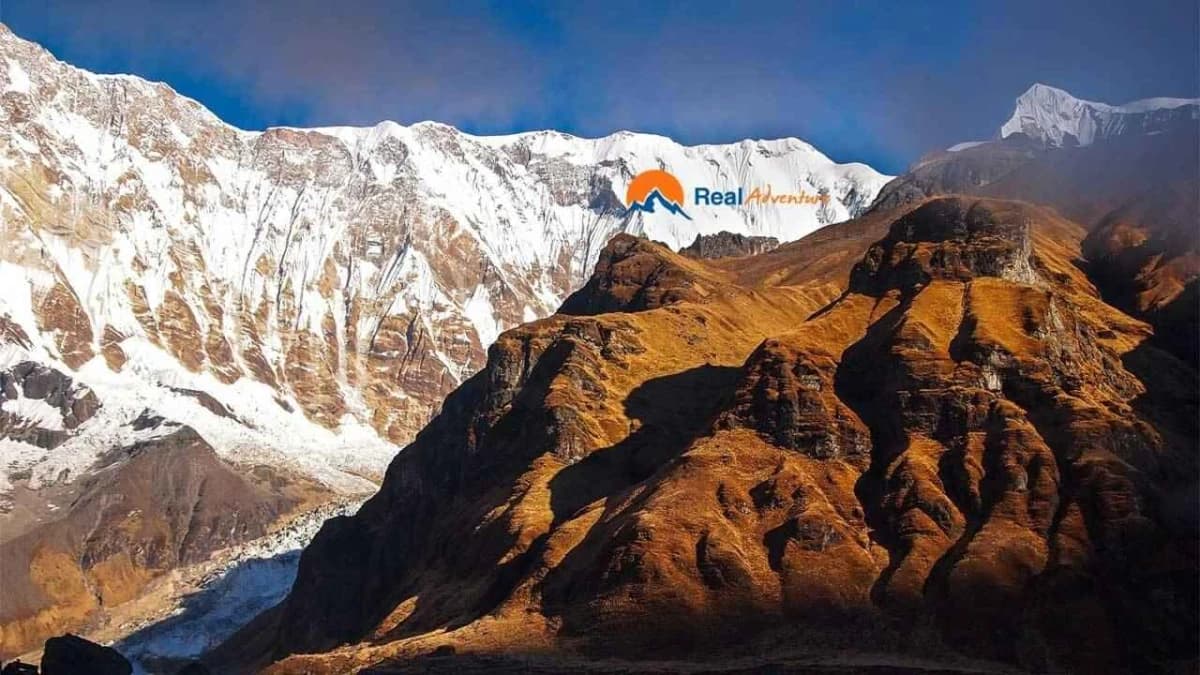
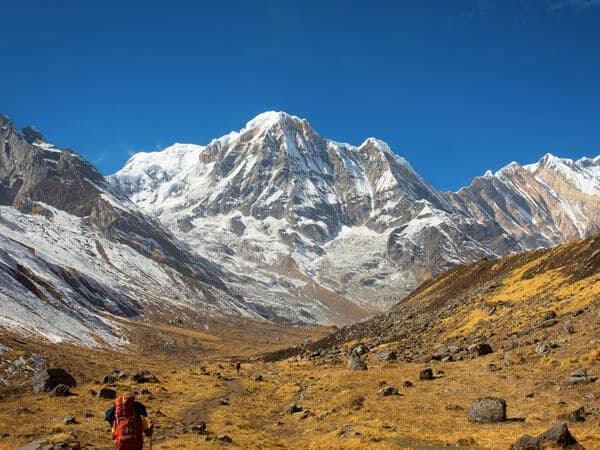
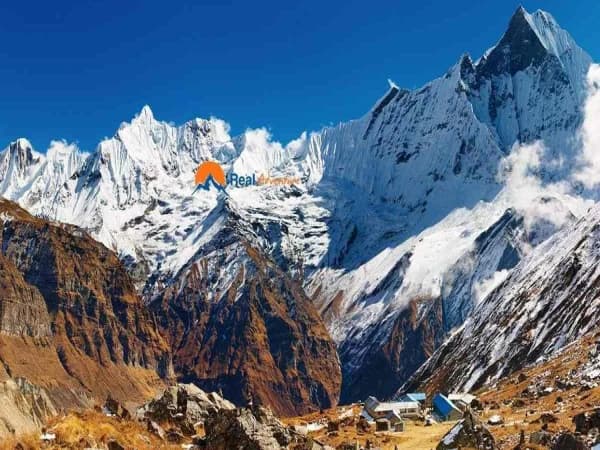
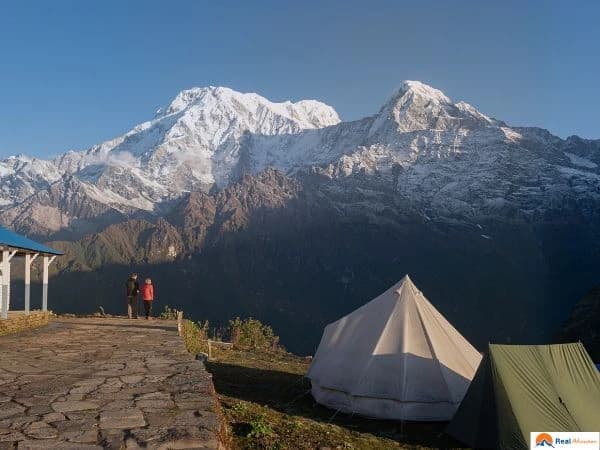
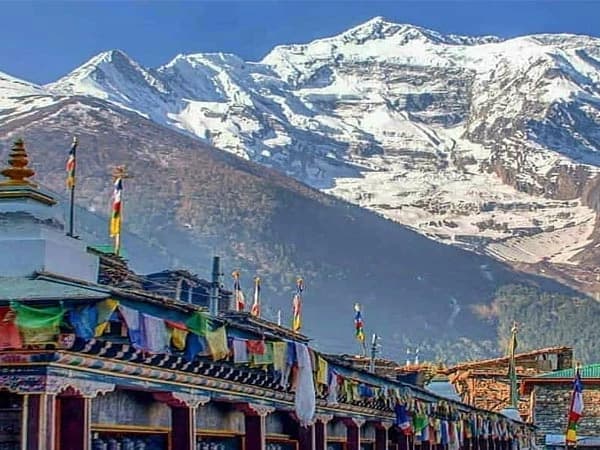
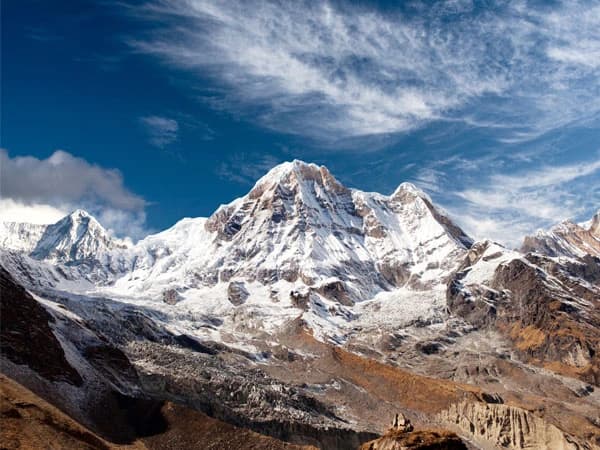
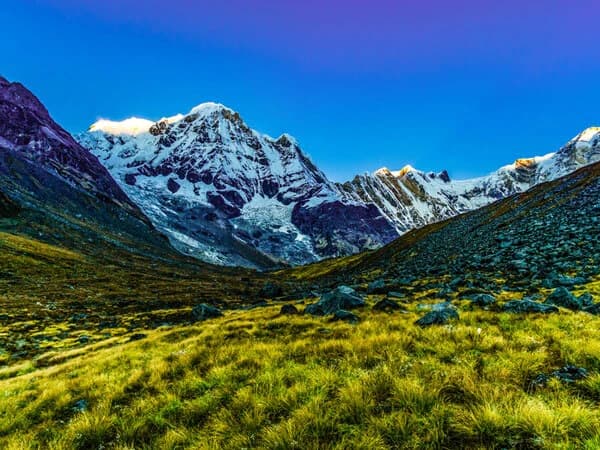
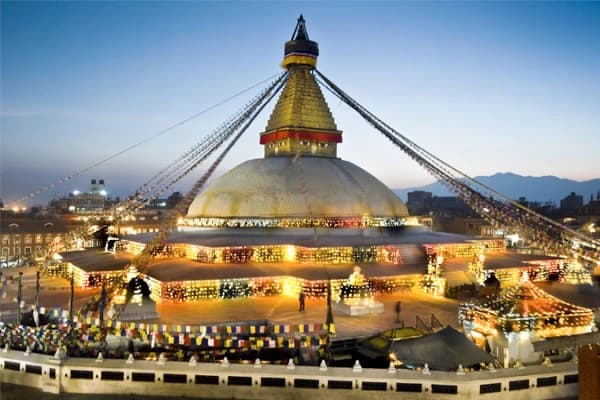
-(5).webp&w=1200&q=75&dpl=dpl_GDHRyonDC5uCJ5MtiFRDmK8W8YHj)
